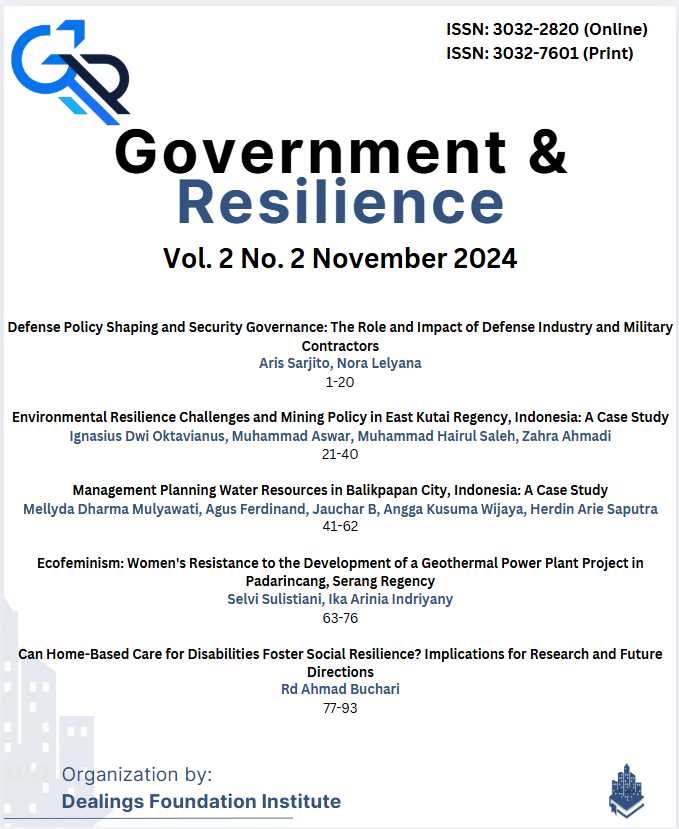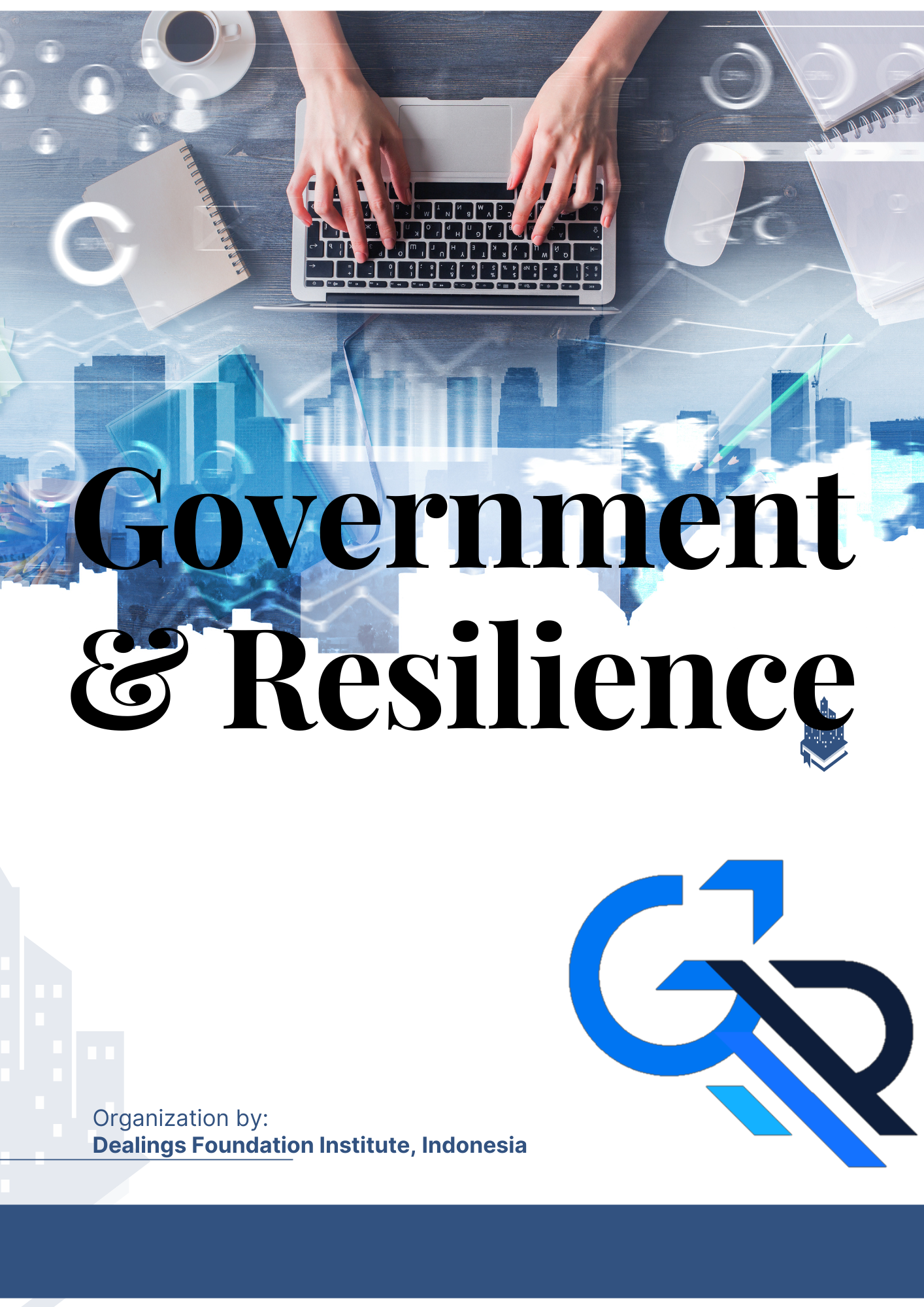Can Home-Based Care for Disabilities Foster Social Resilience? Implications for Research and Future Directions
DOI:
https://doi.org/10.62503/gr.v2i2.20Keywords:
Home-Based Care, Social Resilience, Disabilities, Social Development, Research AgendaAbstract
This research aimed to identify, review, and study the development of scientific publication trends regarding home-based care for disability issues worldwide. This study provides scientific guidance and recommendations for the development of home-based disability care research to create social resilience. The method of this study is a systematic review and meta-analysis through the PRISMA protocol. The findings of this study evaluated the literature review taxonomy through two specific analyses: (1) this study explores the evolution of the research literature from year to year across the three databases on home-based disability care in the last 10 years; and (2) this study investigates whether home-based disability care research has a positive impact on addressing issues of social change, inclusive development, increased sustainability, increased community resilience, and improved quality of life. This research contributes to helping researchers explain, support, and expand the emergence of new theories from the results of research on disability and social issues.
References
Abbas, A., Ekowati, D., Suhariadi, F., & Fenitra, R. M. (2023). Health implications, leaders societies, and climate change: a global review. Ecological footprints of climate change: Adaptive approaches and sustainability, 653-675. https://doi.org/10.1007/978-3-031-15501-7_26
Abdillah, A., Buchari, R. A., Widianingsih, I., & Nurasa, H. (2023b). Climate change governance for urban resilience for Indonesia: A systematic literature review, Cogent Social Sciences, 9: 2235170. https://doi.org/10.1080/23311886.2023.2235170
Abdillah, A., Widianingsih, I., Buchari, R. A., & Nurasa, H. (2023a). Implications of urban farming on urban resilience in Indonesia: Systematic literature review and research identification. Cogent Food & Agriculture, 9(1), 2216484. https://doi.org/10.1080/23311932.2023.2216484
Alcamo, J., Flörke, M., & Märker, M. (2007). Future long-term changes in global water resources driven by socio-economic and climatic changes. Hydrological Sciences Journal, 52(2), 247-275. https://doi.org/10.1623/hysj.52.2.247
Anderson, C., Mhurchu, C. N., Brown, P. M., & Carter, K. (2002). Stroke rehabilitation services to accelerate hospital discharge and provide home-based care: an overview and cost analysis. Pharmacoeconomics, 20, 537-552. https://doi.org/10.2165/00019053-200220080-00004
Arnell, N. W. (2004). Climate change and global water resources: SRES emissions and socio-economic scenarios. Global environmental change, 14(1), 31-52. https://doi.org/10.1016/j.gloenvcha.2003.10.006
Baker, D. I., Gottschalk, M., Eng, C., Weber, S., & Tinetti, M. E. (2001). The design and implementation of a restorative care model for home care. The Gerontologist, 41(2), 257-263. https://doi.org/10.1093/geront/41.2.257
Boris, E., & Klein, J. (2015). Caring for America: Home health workers in the shadow of the welfare state. Oxford University Press.
Buheji, M., da Costa Cunha, K., Beka, G., Mavric, B., De Souza, Y. L., da Costa Silva, S. S., ... & Yein, T. C. (2020). The extent of covid-19 pandemic socio-economic impact on global poverty. a global integrative multidisciplinary review. American Journal of Economics, 10(4), 213-224. https://doi.org/10.5923/j.economics.20201004.02
Cappanera, P., Scutellà, M. G., & Visintin, F. (2014). Home Care Services delivery: equity versus efficiency in optimization models. In Proceedings of the international conference on health care systems engineering (pp. 1-13). Springer International Publishing. https://doi.org/10.1007/978-3-319-01848-5_1
Carter, B., Coad, J., Bray, L., Goodenough, T., Moore, A., Anderson, C., ... & Widdas, D. (2012). Home-based care for special healthcare needs: community children’s nursing services. Nursing Research, 61(4), 260-268. https://doi.org/10.1097/NNR.0b013e31825b6848
Cattafi, M., Herrero, R., Gavanelli, M., Nonato, M., & Malucelli, F. (2012). Improving quality and efficiency in home health care: An application of constraint logic programming for the Ferrara NHS unit. In Technical Communications of the 28th International Conference on Logic Programming (ICLP'12). Schloss Dagstuhl-Leibniz-Zentrum fuer Informatik. https://doi.org/10.4230/LIPIcs.ICLP.2012.415
Chen, M. C., Kao, C. W., Chiu, Y. L., Lin, T. Y., Tsai, Y. T., Jian, Y. T. Z., ... & Kao, S. (2017). Effects of home-based long-term care services on caregiver health according to age. Health and Quality of Life Outcomes, 15, 1-10. https://doi.org/10.1186/s12955-017-0786-6
Chou, Y. C., Kröger, T., & Pu, C. Y. (2015). Models of long-term care use among older people with disabilities in Taiwan: Institutional care, community care, live-in migrant care and family care. European Journal of Ageing, 12, 95-104. https://doi.org/10.1007/s10433-014-0322-z
Cobo, M. J., López-Herrera, A. G., Herrera-Viedma, E., & Herrera, F. (2011). Science mapping software tools: Review, analysis, and cooperative study among tools. Journal of the American Society for Information Science and Technology, 62(7), 1382–1402. https://doi.org/10.1002/asi.21525
De Villiers, L., Badri, M., Ferreira, M., & Bryer, A. (2011). Stroke outcomes in a socio-economically disadvantaged urban community. South African Medical Journal, 101(5), 345-348. https://www.ajol.info/index.php/samj/article/view/69755
Grant, M. J., & Booth, A. (2009). A typology of reviews: an analysis of 14 review types and associated methodologies. Health Information & Libraries Journal, 26(2), 91-108. https://doi.org/10.1111/j.1471-1842.2009.00848.x
Health and Public Policy Committee. (1986). Home health care. Annals of Internal Medicine, 105(3), 454-460. https://doi.org/10.7326/0003-4819-105-3-454
Hestevik, C. H., Molin, M., Debesay, J., Bergland, A., & Bye, A. (2019). Healthcare professionals’ experiences of providing individualized nutritional care for Older People in hospital and home care: a qualitative study. BMC geriatrics, 19(1), 1-9. https://doi.org/10.1186/s12877-019-1339-0
Iezzoni, L. I., Gallopyn, N., & Scales, K. (2019). Historical mismatch between home-based care policies and laws governing home care workers. Health Affairs, 38(6), 973-980. https://doi.org/10.1377/hlthaff.2018.05494
Janicki, M. P., Dalton, A. J., McCallion, P., Baxley, D. D., & Zendell, A. (2005). Group home care for adults with intellectual disabilities and Alzheimer’s disease. Dementia, 4(3), 361-385. https://doi.org/10.1177/1471301205055028
Jones, C. D., & Bowles, K. H. (2020). Emerging challenges and opportunities for home health care in the time of COVID-19. Journal of the American Medical Directors Association, 21(11), 1517-1518. https://doi.org/10.1016/j.jamda.2020.09.018
Kjerstad, E., & Tuntland, H. K. (2016). Reablement in community-dwelling older adults: a cost-effectiveness analysis alongside a randomized controlled trial. Health Economics Review, 6(1), 1-10. https://doi.org/10.1186/s13561-016-0092-8
Landers, S., Madigan, E., Leff, B., Rosati, R. J., McCann, B. A., Hornbake, R., ... & Breese, E. (2016). The future of home health care: a strategic framework for optimizing value. Home Health Care Management & Practice, 28(4), 262-278. https://doi.org/10.1177/1084822316666368
Liyandi, M. J., Indriyany, I. A., & Prastio, L. O. (2024). “Sekolah Ibu Program”: Women Resilience Program or Gender Blind Policy?. Government & Resilience, 2(1), 46-57. https://doi.org/10.62503/gr.v2i1.13
Lorant, V., Croux, C., Weich, S., Deliège, D., Mackenbach, J., & Ansseau, M. (2007). Depression and socio-economic risk factors: 7-year longitudinal population study. The British journal of psychiatry, 190(4), 293-298. https://doi.org/10.1192/bjp.bp.105.020040
Maart, S., & Jelsma, J. (2014). Disability and access to health care–a community based descriptive study. Disability and Rehabilitation, 36(18), 1489-1493. https://doi.org/10.3109/09638288.2013.807883
Mofijur, M., Fattah, I. R., Alam, M. A., Islam, A. S., Ong, H. C., Rahman, S. A., ... & Mahlia, T. M. I. (2021). Impact of COVID-19 on the social, economic, environmental and energy domains: Lessons learnt from a global pandemic. Sustainable production and consumption, 26, 343-359. https://doi.org/10.1016/j.spc.2020.10.016
Mol, A. (2008). The logic of care: Health and the problem of patient choice. Routledge.
Moral-Muñoz, J. A., Herrera-Viedma, E., Santisteban-Espejo, A., & Cobo, M. J. (2020). Software tools for conducting bibliometric analysis in science: An up-to-date review. Profesional de la Información, 29(1). https://doi.org/10.3145/epi.2020.ene.03
Murashima, S., Nagata, S., Magilvy, J. K., Fukui, S., & Kayama, M. (2002). Home care nursing in Japan: a challenge for providing good care at home. Public health nursing, 19(2), 94-103. https://doi.org/10.1046/j.1525-1446.2002.19204.x
Nafi’ah, B. A., Roziqin, A., Suhermanto, D. F., & Fajrina, A. N. (2021). The Policy Studies journal: A Bibliometric and mapping study from 2015-2020. Library Philosophy and Practice, 2021, 1–18. https://digitalcommons.unl.edu/libphilprac/5881/
Nakamura, K., Takano, T., & Akao, C. (1999). The effectiveness of videophones in home healthcare for the elderly. Medical care, 117-125. https://www.jstor.org/stable/3767217
National Research Council. (2011). Health care comes home: the human factors. National Academies Press.
Patel, S. K., & Jhalani, P. (2023). Formulation of variables of environmental taxation: a bibliometric analysis of Scopus database (2001–2022). Environment, Development and Sustainability, 1-28. https://doi.org/10.1007/s10668-023-03027-0
Piercy, K. W., & Woolley, D. N. (2000). Negotiating worker-client relationships: A necessary step to providing quality home health care. Home Health Care Services Quarterly, 18(1), 1-24. https://doi.org/10.1300/J027v18n01_01
Pozzilli, C., Brunetti, M., Amicosante, A. M. V., Gasperini, C., Ristori, G., Palmisano, L., & Battaglia, M. (2002). Home-based management in multiple sclerosis: results of a randomized controlled trial. Journal of Neurology, Neurosurgery & Psychiatry, 73(3), 250-255. https://doi.org/10.1136/jnnp.73.3.250
Putera, P. B., Suryanto, S., Ningrum, S., Widianingsih, I., & Rianto, Y. (2022). three decades of discourse on science, technology, and innovation in national innovation system: A Bibliometric Analysis (1990–2020). Cogent Social Sciences, 8(1), 2109854. https://doi.org/10.1080/23311886.2022.2109854
Qiu, W. Q., Dean, M., Liu, T., George, L., Gann, M., Cohen, J., & Bruce, M. L. (2010). Physical and mental health of homebound older adults: an overlooked population. Journal of the American Geriatrics Society, 58(12), 2423-2428. https://doi.org/10.1111/j.1532-5415.2010.03161.x
Raihan, A. (2023). A review of the global climate change impacts, adaptation strategies, and mitigation options in the socio-economic and environmental sectors. Journal of Environmental Science and Economics, 2(3), 36-58. https://doi.org/10.56556/jescae.v2i3.587
Rusliadi, R., & Aina, A. N. (2024). Social Welfare Policy and Cross-Sectoral Participation: For Resilience Overcoming Stunting in Indonesia. Government & Resilience, 2(1), 1-13. https://doi.org/10.62503/gr.v2i1.10
Sama, S. R., Quinn, M. M., Galligan, C. J., Karlsson, N. D., Gore, R. J., Kriebel, D., ... & Lindberg, J. E. (2021). Impacts of the COVID-19 pandemic on home health and home care agency managers, clients, and aides: a cross-sectional survey, March to June, 2020. Home Health Care Management & Practice, 33(2), 125-129. https://doi.org/10.1177/1084822320980415
Shang, J., Chastain, A. M., Perera, U. G. E., Quigley, D. D., Fu, C. J., Dick, A. W., ... & Stone, P. W. (2020). COVID-19 preparedness in US home health care agencies. Journal of the American Medical Directors Association, 21(7), 924-927. https://doi.org/10.1016/j.jamda.2020.06.002
Shaughnessy, P. W., Crisler, K. S., Schlenker, R. E., Arnold, A. G., Kramer, A. M., Powell, M. C., & Hittle, D. F. (1994). Measuring and assuring the quality of home health care. Health care financing review, 16(1), 35. https://pubmed.ncbi.nlm.nih.gov/10140157
Stanhope, M., & Lancaster, J. (2015). Public health nursing: Population-centered health care in the community. Elsevier Health Sciences.
Szanton, S. L., Leff, B., Wolff, J. L., Roberts, L., & Gitlin, L. N. (2016). Home-based care program reduces disability and promotes aging in place. Health Affairs, 35(9), 1558-1563. https://doi.org/10.1377/hlthaff.2016.0140
Valdmanis, V. G., Rosko, M. D., Leleu, H., & Mukamel, D. B. (2017). Assessing overall, technical, and scale efficiency among home health care agencies. Health care management science, 20, 265-275. https://doi.org/10.1007/s10729-015-9351-1
Van Eck, N., & Waltman, L. (2010). Software survey: VOSviewer, a computer program for bibliometric mapping. Scientometrics, 84(2), 523-538. https://doi.org/10.1007/s11192-009-0146-3
Woodward, C. A., Abelson, J., Tedford, S., & Hutchison, B. (2004). What is important to continuity in home care?: Perspectives of key stakeholders. Social science & medicine, 58(1), 177-192. https://doi.org/10.1016/S0277-9536(03)00161-8
World Health Organization. (2015). The growing need for home health care for the elderly: Home health care for the elderly as an integral part of primary health care services.
Yamada, Y. (2002). Profile of home care aides, nursing home aides, and hospital aides: Historical changes and data recommendations. The Gerontologist, 42(2), 199-206. https://doi.org/10.1093/geront/42.2.199
Zeng, Y., Chen, H., Wang, Z., & Land, K. C. (2015). Implications of changes in households and living arrangements for future home-based care needs and costs for disabled elders in China. Journal of aging and health, 27(3), 519-550. https://doi.org/10.1177/0898264314552690
Downloads
Published
How to Cite
Issue
Section
License
Copyright (c) 2024 Government & Resilience

This work is licensed under a Creative Commons Attribution-NonCommercial-ShareAlike 4.0 International License.
1. Licence
Use of articles will be governed by the Creative Commons Attribution-NonCommercial-ShareAlike 4.0 International license as currently displayed on the Creative Commons Attribution-NonCommercial-ShareAlike 4.0 International License (CC BY-NC-SA 4.0).
2. Author(s)' Warranties
The author warrants that the article is original, written by the stated author(s), has not been published before, contains no unlawful statements, does not infringe the rights of others, is subject to copyright that is vested exclusively in the author and free of any third-party rights, and that any necessary written permissions to quote from other sources have been obtained by the author(s).
3. User Rights
The spirit of Government & Resilience is to disseminate articles published as freely as possible. Under the Creative Commons license, Government & Resilience permits users to copy, distribute, display, and perform the work. Users will also need to attribute authors and Government & Resilience for distributing works in journals and other media of publication.
4. Rights of Authors
Authors retain all their rights to the published works, such as (but not limited to) the following rights:
1. Copyright and other proprietary rights relating to the article, such as patent rights,
2. The right to use the substance of the article in future works, including lectures and books,
3. The right to reproduce the article for own purposes,
4. The right to enter into separate, additional contractual arrangements for the non-exclusive distribution of the article's published version (e.g., post it to an institutional repository or publish it in a book), with an acknowledgment of its initial publication in this journal (Government & Resilience).
5. Co-Authorship
If the article was jointly prepared by more than one author, any author submitting the manuscript warrants that he or she has been authorized by all co-authors to agree on this copyright and license notice (agreement) on their behalf and agrees to inform his or her co-authors of the terms of this policy. Government & Resilience will not be held liable for anything that may arise due to the author's internal dispute. Government & Resilience will only communicate with the corresponding author.
6. Royalties
Being an open-access journal and disseminating articles for free under the Creative Commons license term mentioned, the author(s) are aware that Government & Resilience entitles the author(s) to no royalties or other fees.











